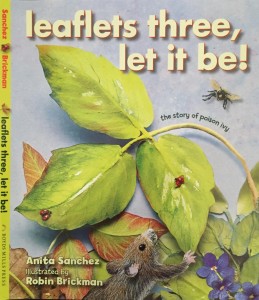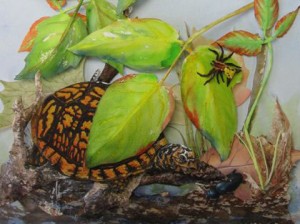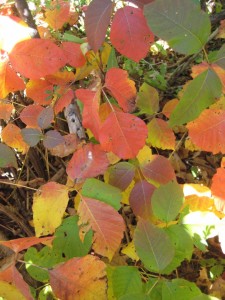About the Book
 In Leaflets Three, Let It Be, author Anita Sanchez and illustrator Robin Brickman use descriptive text and detailed pictures to tell the story of poison ivy. While poison ivy may not be popular with people, it can be a lifesaver for animals. In fact poison ivy provides food and shelter for many different creatures, from mice to moose.
In Leaflets Three, Let It Be, author Anita Sanchez and illustrator Robin Brickman use descriptive text and detailed pictures to tell the story of poison ivy. While poison ivy may not be popular with people, it can be a lifesaver for animals. In fact poison ivy provides food and shelter for many different creatures, from mice to moose.
The author also offers helpful tips for identifying poison ivy as it changes through the seasons so that the reader can avoid contact with the plant. This educator’s guide can be used to enhance a young reader’s experience with the book and suggests some activities for further exploration.
Boyds Mills Press, 2015 www.boydsmillspress.com
Pre-reading activity
Look at the front and back covers. What do you see? What do you think this book is about? (CCSS Literacy SL 1.2)
How many animals do you see on the front and back covers? Are some of them hiding? Do they use camouflage? (CCSS Literacy SL 1.2)
Discussion Questions and Research
On the first page of the book, the author writes, “Hairy vine—a warning sign!” What is a vine? How does it stay on the tree? [Poison ivy vines have fur-like rootlets all along their length. The rootlets give off a sticky substance, like glue, that helps them cling to the bark] Describe what the vine looks like. (CCSS Literacy RI 1.1, 1.7)
What color are poison ivy leaves in springtime? What words does the author use to help readers remember to look out when they see poison ivy in the spring? (CCSS Literacy RI 1.6)
What does the rabbit do when it sees poison ivy? Is poison ivy a good thing for the rabbit? Why? (CCSS Literacy RI 1.4)
Look at the picture of the deer and the white-footed mice. How are poison ivy leaves different from most other leaves in springtime? (CCSS Literacy RI 1.1)
In summer, the red leaves fade to green, and poison ivy begins to hide among the other plants. How many different kinds of plants do you see in the picture? [Hint: Count the leaves.] (CCSS Literacy RI 1.1)
What makes poison ivy grow strong in summer? Where does the plant grow? Why do you need to “watch where you step?” (CCSS Literacy RI 1.1, 1.8)
What did the cardinals use to make their nest? What is the mother cardinal bringing to her nestlings in the picture? (CCSS Literacy RI 1.1)
“Bees hum and buzz among the blossoms, gathering poison ivy nectar.” What do the bees make with the nectar? [Bees turn the nectar into delicious honey. Fortunately there’s no urushiol in the nectar, so the honey is safe to eat.] (CCSS Literacy RI 1.1)
It’s autumn. What are some of the insects that like to feed on poison ivy leaves? (CCSS Literacy RI 1.1) [Hundreds of species of insects use poison ivy for food and shelter, including thirty-five different types of beetles, two species of fly, two kinds of wasps, five types of aphids, and thirty-seven species of caterpillars. In addition, more than thirty other species of insects and mites feed on poison ivy. That’s not even counting the dozens of species of insects which use the plant for shelter or egg-laying.]
How is poison ivy a living bird feeder? Name some of the birds it feeds in winter. (CCSS Literacy RI 1.1, 1.4) [Birds pictured in the book include bluebird, robin, chickadee, wild turkey, and cardinal. One bird-watcher spotted five different species of woodpecker feasting on the same poison ivy vine!]
Post-reading activities
The poison ivy plant looks different at different times of the year. Look though the book and discuss poison ivy’s appearance through the seasons. (CCSS Literacy RI 1.1, SL 1.2)
“Like snowflakes, no two poison ivy leaves are exactly alike.” What are some of the sayings the author offers to help you identify poison ivy? Is it easier to remember things if they’re in rhyme? (CCSS Literacy RI 1.1, SL 1.2)
In the book a cranky bear, woken from a long sleep, wants a bite too. Why is the bear sleeping? [Instead of finding food all winter long, bears sleep through the cold weather.] (CCSS Literacy RI 1.1, SL 1.3)
Look carefully at the illustrations. Count how many animals you can find eating poison ivy or sheltering in or near poison ivy. Remember that “animal” can include birds, insects, reptiles, amphibians and mammals. [There are a lot of animals in the pictures–more than fifty!] (CCSS Literacy W 1.7)
There are many words describing plant parts in the book. How many can you find? [Bud, flower, seedling, sap, and nectar are some of the plant words.] (CCSS Literacy L1.4)
“When winter comes the forest seems barren.” What do you think barren means? Is the forest really barren? Why or why not? (CCSS Literacy L1.4 SL 1.2)
“Leaves glow scarlet, orange, gold—a poison ivy rainbow!” The words make poison ivy sound beautiful. Before you read this book, what did you think about poison ivy? Now what do you think? Discuss how the way you think about poison ivy may have changed. (CCSS Literacy SL 1.2)
Make a list of adjectives (words that describe). How many words does the author use to describe poison ivy? (Hairy, tender, plump, scarlet, and snug are just a few.) What adjectives describe animals? (Cranky, thin, and golden-eyed are some of them.) SL 1.2
Make a list of verbs (action words) the author uses. What verbs describe poison ivy’s actions? (Creeps, clings, pop, fade, hide, and shine are some.) What verbs are used to describe animals? (Look for roll, tunnel, wriggle and gnaw). SL 1.2
What color are leaves? Are they just green? How many colors does the artist use to paint poison ivy? Can you find all the colors of the rainbow on a poison ivy vine? (Red, orange, yellow, green, blue, purple). Blue is hard to find in nature—leaves rarely turn blue.
Extra Credit
No one likes to get an itchy rash from poison ivy, but the author explains the important role poison ivy plays in the lives of animals. Think about something else from the natural world that you may not like—mosquitoes, for example. Now think about the ways mosquitoes might be important in the lives of other creatures.
In the question and answer section at the back of the book, the author writes that poison ivy prevents soil erosion. What is erosion? Is it good or bad?
| POISON IVY ART
Illustrator Robin Brickman created the artwork for this book using a technique called collage. The three-dimensional paintings seem to jump off the page. At the back of the book she explains how she did it: “I created the artwork for this book with watercolors and acrylic paints on paper, cutting and shaping the painted paper by hand, and gluing it in place.” Try to make your own nature collage using the same technique as the author. Cut a leaf shape out of paper, and then paint it. Once the paint is dry, shape the paper so it bends and curves like a real leaf. Add the shapes of painted caterpillars, beetles, or butterflies. Add flowers, or cut holes in the leaf that look like bug chewings. Maybe add a painted mouse or bear. You can move the shapes around and decide where they go. When you have a design you like, glue them all down on a big sheet of paper. Check out Robin Brickman’s other books: –One Night in the Coral Sea –A Log’s Life –I Am an Artist
She illustrates beautiful habitats like coral reefs and forests. What habitat would you choose to illustrate? |
To Order Leaflets Three: Contact a Perseus Books Group Sales representative at [email protected]
(800) 343-4499 or
Boyds Mills Press [email protected]
[The above guide was prepared by Jane Becker and Anita Sanchez]
Poison Ivy and You
How does just touching a plant make me itchy?
Poison ivy sap contains an oily chemical called urushiol. If you brush against any part of the plant, this oil can get onto your skin. If you’re allergic to urushiol, you might develop an itchy rash.
Approximately eighty-five per cent of humans are allergic to poison ivy. But don’t assume you’re out of the woods if you brush against the plant and nothing happens. Usually you won’t get a rash the first time you touch poison ivy. But your body can become sensitized to it, and you might get a rash next time.
Can I get poison ivy just from walking past it?
You have to get the oil directly on your skin. You might get it from clothes or pets that have touched poison ivy.
What happens when I touch poison ivy? Does it hurt?
Not a bit. It’s not like being stung by an angry wasp or pricked by a thorny thistle. Most people never even notice poison ivy as they walk through it.
At first, nothing happens. It usually takes a day or so for a red-colored rash to develop. Blisters may pop up, too.
What should I do if I’ve touched poison ivy?
Wash off the oil as soon as possible. Use lots of cool water—soap isn’t necessary. If you’re far from a sink, rinse off in a stream, or go swimming.
Do I have poison ivy, poison oak, or poison sumac?
Doesn’t really matter—they all contain urushiol. Symptoms and treatment of poison ivy, poison oak, and poison sumac rashes are essentially the same.
There are two species of poison ivy, one that grows on the ground, one that can be a vine. They look very similar. Poison oak is a shrub with oak-shaped leaves. Poison sumac is a small tree with white berries.
Shouldn’t we spray poison ivy, or get rid of it somehow?
Think carefully before using an herbicide. Herbicides are poisons that kill unwanted plants, but their powerful chemicals can harm people’s health. Herbicides can hurt animals, too—dogs, cats, birds, frogs, butterflies, and more.
Why does such a bad plant exist?
Plants aren’t “bad” or “good.” They just are! Poison ivy is native to this continent—it was here long before people. No one knows why humans are allergic to this plant.
You wouldn’t run into the street without looking both ways, would you? Walk carefully in the forest, and you’ll recognize poison ivy if you see it!
What Do You Think?
Which of these plants is poison ivy?








Recent Comments